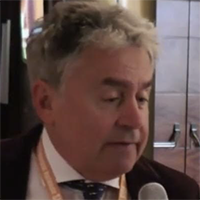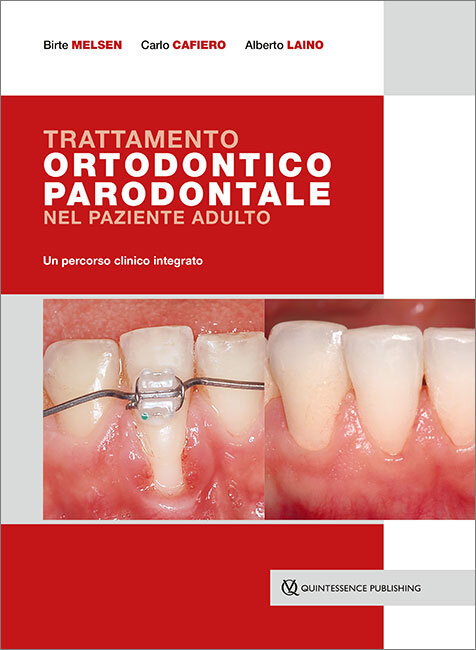The International Journal of Oral & Maxillofacial Implants, 1/2016
DOI: 10.11607/jomi.4130, PubMed ID (PMID): 26800173Pagine 162-166, Lingua: IngleseIorio-Siciliano, Vincenzo / Marenzi, Gaetano / Blasi, Andrea / Mignogna, Jolanda / Cafiero, Carlo / Wang, Hom-Lay / Sammartino, GilbertoPurpose: The aim of this case series study was to evaluate clinical and radiographic changes of soft and hard tissues around tapered, platform-switched, laser-microtextured implants 24 months after crown placement.
Materials and Methods: Twenty tapered, platform-switched, laser-microtextured collar implants were placed in 20 patients. Full-mouth plaque score, full-mouth bleeding score, probing depth, and mucosal recession were recorded at the time of crown cementation and after 24 months follow-up. The marginal bone-level changes at the mesial and distal aspects of the implants were calculated by subtracting from baseline and 24-month implant marginal bone level.
Results: In terms of the full-mouth plaque score and full-mouth bleeding score, tapered, platformswitched, laser-microtextured implants showed statistically significant improvements at 6 months when compared to baseline (P .001). Statistically significantly deeper probing depths (P .001) were found when comparing baseline and at 24 months at mesial, lingual, and distal sites. However, no statistically significant difference was found at the buccal aspects (P = .064). Radiographic marginal bone loss at 2-year follow-up for tapered, platformswitched, laser-microtextured implants was 0.72 ± 0.16 mm and 0.67 ± 0.15 mm at the mesial and distal sites, respectively.
Conclusion: Within the limits of this study, tapered, platform-switched, laser-microtextured implants maintained marginal bone level (less than 1 mm radiographic bone loss) as well as limited mucosa recession over a 2-year period.
Parole chiave: bone loss, dental implant, implant marginal, implant surface, laser-microtexture, platform switch
International Journal of Periodontics & Restorative Dentistry, 4/2014
DOI: 10.11607/prd.1678, PubMed ID (PMID): 25006771Pagine 540-549, Lingua: IngleseIorio-Siciliano, Vincenzo / Marzo, Giuseppe / Blasi, Andrea / Cafiero, Carlo / Mignogna, Michele / Nicolò, MicheleHistologic and clinical studies confirm that laser-microtextured implant collars favor the attachment of connective fibers and reduce probing depth and periimplant bone loss when compared with machined collars. This prospective study aimed at assessing the alveolar dimensional changes after immediate placement of a transmucosal implant with a Laser-Lok microtextured collar associated with bone regenerative procedures. Thirteen implants were placed immediately into single-rooted extraction sockets. Peri-implant defects were treated with bovinederived xenografts and resorbable collagen membranes. At 6-month surgical reentry, the Laser-Lok microtextured collar provided more favorable conditions for the attachment of hard and soft tissues and reduced the alveolar bone loss.
Quintessence International, 3/2013
DOI: 10.3290/j.qi.a29054, PubMed ID (PMID): 23444204Pagine 231-240, Lingua: IngleseBriguglio, Francesco / Briguglio, Enrico / Briguglio, Roberto / Cafiero, Carlo / Isola, GaetanoObjective: This randomized clinical study examined the use of hyaluronic acid to treat infrabony periodontal defects over a period of 24 months.
Method and Materials: Forty subjects with a two-wall infrabony defect (probing depth [PD] >= 7 mm; clinical attachment level [CAL] >= 7 mm) were selected. The defects were randomly divided into two groups: sites treated with hyaluronic acid (test group) and those treated with open flap debridement (control group).
Results: The 12- and 24-month evaluations were based on clinical and radiographic parameters. The primary outcome variable was CAL. Test defects shows a mean CAL gain of 1.9 ± 1.8 mm, while the control defects yielded a significantly lower gain of 1.1 ± 0.7 mm. PD reduction was also significantly higher in the test group (1.6 ± 1.2 mm) than in the control group (0.8 ± 0.5 mm). Frequency distribution analysis of the study outcomes indicated that hyaluronic acid increased the predictability of clinically significant results (CAL gains >= 2 mm and PD reduction >= 2 mm) in the test group compared with the controls.
Conclusions: The treatment of infrabony defects with hyaluronic acid offered an additional benefit in terms of CAL gain, PD reduction, and predictability compared to treatment with open flap debridement.
Parole chiave: hyaluronic acid, infrabony periodontal defect, periodontal disease, periodontal regeneration, randomized clinical trial
International Journal of Periodontics & Restorative Dentistry, 5/2005
Pagine 461-473, Lingua: IngleseFrancetti, Luca/Trombelli, Leonardo/Lombardo, Giorgio/Guida, Luigi/Cafiero, Carlo/Roccuzzo, Mario/Carusi, Giorgio/Del Fabbro, MassimoThe aim of this prospective multicenter controlled clinical study was to evaluate the efficacy of Emdogain (Biora), an enamel matrix derivative (EMD), when combined with surgical treatment of periodontal angular defects, as compared to surgery alone, for up to 24 months of follow-up. The study was performed at six Italian universities and 11 private practices. Patients with one-, two-, or three-wall angular defects were enrolled if intrabony defect depth (IBD) was 4 mm or more and probing pocket depth (PPD) was at least 6 mm. They were randomly allocated to either test or control groups. The test group was treated by the simplified papilla preservation (SPP) flap plus Emdogain after root conditioning with ethylenediaminetetraacetic acid. The control group was treated by SPP alone. Plaque Index, Gingival Index, PPD, and periodontal attachment level (PAL) at surgical sites were assessed at the presurgical examination (baseline). IBD was measured intraoperatively after debridement. IBD was also evaluated with a computeraided technique, from periapical radiographs. Plaque Index, Gingival Index, PPD, PAL, and IBD were assessed at 12 and 24 months postsurgery. Data were further divided in two subgroups according to baseline IBD (6 mm or less and more than 6 mm). The differences between each follow-up and baseline, and between groups at each follow-up, for the above parameters were evaluated by standard statistical methods. One hundred fifty-three patients were recruited, accounting for 195 intrabony defects: 83 patients (108 defects) and 70 patients (87 defects) were allocated to the test and control groups, respectively. All parameters were improved at both 12 and 24 months, compared to baseline in both groups. In the test group, IBD, PPD, and PAL at 12 months were significantly better than these parameters in the control group. The test subgroup with IBD of more than 6 mm at baseline displayed a better outcome when compared to the 6 mm or less IBD subgroup. No significant adverse events related to the use of Emdogain were reported. The use of EMD as an adjunct to periodontal surgery in the treatment of angular defects significantly enhanced the rate and degree of periodontal regeneration. The control group also displayed significant tissue regeneration, but at a slower rate compared to the Emdogain group. The surgical procedure itself, with its goal of maximum preservation of the regenerative potential of periodontal tissues, proved to be effective in the treatment of periodontal angular defects. Pockets with IBD greater than 6 mm showed major improvement when treated with Emdogain.




